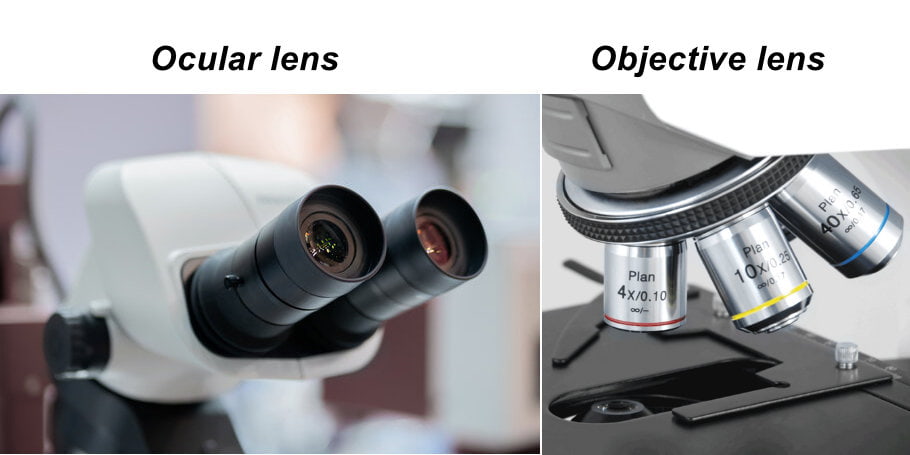
Optical microscopes are a type of microscope that uses visible light to see objects. However, the wavelength of visible light is greater than that of bacteria and viruses, so they are difficult to see with an optical microscope. An optical microscope can magnify objects up to 2,000 times, but that’s not enough to see bacteria and viruses.
Electron microscopes are a type of microscope that uses electrons to see objects. Electrons have a much shorter wavelength than visible light, so an electron microscope can magnify objects up to millions of times. This makes it ideal for seeing very small things like bacteria and viruses.
Details of the most important microscope lenses: The eyepiece that is at the top and you look through it. The objective lens is what magnifies the multiplet you are looking at in the eyepiece. For example, the eyepiece is usually 10×, and the objective lens usually consists of four rotating lenses, from 4× to 100×, and may increase by a small number. This makes 10 x 100 equal to 1000 times magnification.
What microscope is suitable for seeing bacteria? How many times does it magnify:
The appropriate microscope to view bacteria is a compound light microscope. This microscope consists of two main lenses, the objective lens and the eyepiece. The objective lens focuses light onto the sample, while the eyepiece magnifies the resulting image. The price of a regular microscope ranges from $100 to $1000.
A compound light microscope can be used to magnify bacteria up to 1,000 times. However, most bacteria can only be seen with magnification between 1,000 and 2,000 times.
There are several types of compound light microscopes that can be used to view bacteria. These types include:
Ordinary microscope: It is a simple type of compound light microscope that can be used to view bacteria in general.
Phase contrast microscopy: This microscope uses refractive index differences between bacteria and their surrounding environment to improve the contrast between the two.
Fluorescence microscopy: This microscope uses fluorescent dyes to stain bacteria, making them easier to see.
In general, a compound light microscope is the most practical option for viewing bacteria. It can be used to see most types of bacteria with sufficient magnification, and is available at relatively affordable prices. You may find a microscope designed for children for a price not exceeding $40.
This is not recommended for culture of bacteria. It is only for culture of cells and is educational for children and not for medical or air students who are obsessed with this science and technology.
What is the appropriate microscope to see viruses and what magnification is required:
The appropriate microscope to see viruses is an electron microscope. Viruses range in size from 20 nm to 450 nm, and are much smaller than cells, which average 10 micrometers in size. The maximum discrimination power of an optical microscope is about 2,000 times greater, meaning it cannot distinguish between objects smaller than 0.2 micrometers. Therefore, an optical microscope cannot be used to see viruses.
An electron microscope uses a beam of electrons instead of light to create images. The discrimination power of an electron microscope can reach millions of times, making it suitable for seeing viruses.
Viewing viruses using an electron microscope requires 10,000 to 100,000 times magnification. Some larger viruses, such as the smallpox virus, require less magnification.
There are two main types of electron microscopes: scanning electron microscopes and transmission electron microscopes. A scanning electron microscope uses a beam of electrons to create a raster image of the sample. A transmission electron microscope uses a beam of electrons to create a continuous image of a sample.
The transmission electron microscope is the most common type of electron microscope used to see viruses. It provides sharper images than a scanning electron microscope, but it is also more expensive.
Electron microscopes are used in a variety of applications, including scientific research, medicine, and industry. They are used to study viruses, bacteria and other microorganisms. It is also used to examine medical samples, such as blood and tissue samples.
Electron microscope prices range from 10,000 to 500,000 dollars. Electron microscopes can be purchased at relatively affordable prices for schools, universities, and individual researchers. Prices for these microscopes range from several thousand to tens of thousands of dollars.










